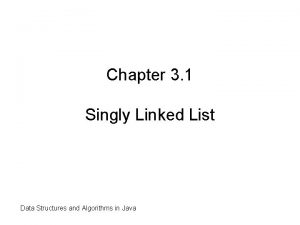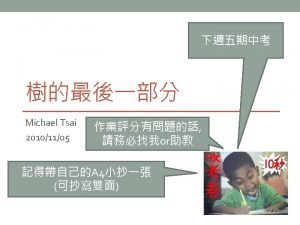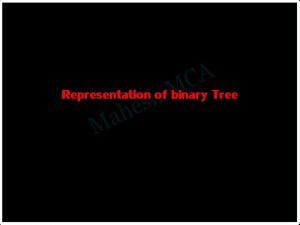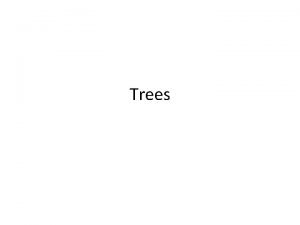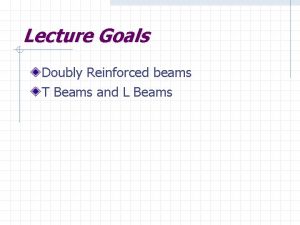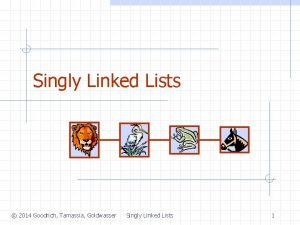Singly Linked Lists Representation Space Analysis Creation and













- Slides: 13

Singly Linked Lists • Representation • Space Analysis • Creation and Insertion • Traversal • Search • Deletion

Representation • We are using a representation in which a linked list has both head and tail references. public class My. Linked. List{ protected Element head; protected Element tail; public final class Element{ Object data; Element next; Element(Object obj, Element element){ data = obj; next = element; } public Object get. Data(){return data; } public Element get. Next(){return next; } } } list head tail

Representation: Space Analysis • Now, we can take a look at the space requirements: S(n) = sizeof(My. Linked. List) + n sizeof(My. Linked. List. Element) = 2 sizeof(My. Linked. List. Element ref) + n [sizeof(Object ref) + sizeof(My. Linked. List. Element ref)] = (n + 2) sizeof(My. Linked. List. Element ref) + n sizeof(Object ref) Space Require Explanation sizeof(My. Linked. List) The list reference has two fields: head (type: Element) and tail (type: Element) = 2 sizeof(My. Linked. List. Element ref) n sizeof(My. Linked. List. Element) The list has n elements of type Element. Each element has two fields-- data (type Object) and next (type Element).

List Creation and Insertion • An empty list is created as follows: head My. Linked. List list = new My. Linked. List(); tail • Once created, elements can be inserted into the list using either the append or prepend methods for (int k = 0; k < 10; k++) list. append(new Integer(k)); • Also if we have reference to a node (an element), we can use insert. After or Insert. Before of the Element class.

Insertion at the end (Append) public void append(Object obj){ Element element = new Element(obj, null); if(head == null) head = element; else tail. next = element; tail = element; } Complexity is O(1)

Insertion at the beginning (Prepend) public void prepend(Object obj) { Element element = new Element(obj, head); if(head == null) tail = element; head = element; Complexity is O(1) }

Insertion before and after an element public void insert. Before(Object obj) { Element element = new Element(obj, this); if(this == head) { head = element; return; } Complexity is O(n) Element previous = head; while (previous. next != this) { previous = previous. next; } previous. next = element; } public void insert. After(Object obj) { next = new Element(obj, next); if(this == tail) tail = next; Complexity is O(1) }

Traversal To move a reference e from one node to the next: e = e. next; Example: Count the number of nodes in a linked list. public int count. Nodes(){ int count = 0; Element e = head; while(e != null){ count++; e = e. next; Complexity is O(n) } return count; }

Searching • To search for an element, we traverse from head until we locate the object. Example: Count the number of nodes with data field equal to a given object. public int count. Nodes(Object obj){ int count = 0; Element e = head; while(e != null){ if(e. data. equals(obj)) count++; Complexity is O(n) e = e. next; } return count; }

Deletion • To delete an element, we use either the extract method of My. Linked. List or that of the Element inner class. public void extract(Object obj) { Element element = head; Element previous = null; while(element != null && ! element. data. equals(obj)) { previous = element; element = element. next; Complexity } is O(n) if(element == null) throw new Illegal. Argument. Exception("item not found"); if(element == head) head = element. next; else previous. next = element. next; if(element == tail) tail = previous; }

Deletion - Difference between the My. Linked. List and the Element extracts • To delete an element, we use either the extract method of My. Linked. List or that of the Element inner class. try{ list. extract(obj 1); } catch(Illegal. Argument. Exception e){ System. out. println("Element not found"); } My. Linked. List. Element e = list. find(obj 1); if(e != null) e. extract(); else System. out. println("Element not found");

Deletion – Deleting First and Last Element public void extract. First() { if(head == null) throw new Illegal. Argument. Exception("item not found"); head = head. next; if(head == null) tail = null; Complexity } public void extract. Last() { if(tail == null) throw new Illegal. Argument. Exception("item not found"); if (head == tail) head = tail = null; else { Element previous = head; Complexity while (previous. next != tail) previous = previous. next; previous. next = null; tail = previous; } } is O(1) is O(n)

Exercises • For the My. Linked. List class, Implement each of the following methods: – String to. String() – Element find(Object obj) – void insert. At(int n) //counting the nodes from 1. State the complexity of each method. • Which methods are affected if we do not use the tail reference in My. Linked. List class.
 Singly vs doubly linked list
Singly vs doubly linked list Singly linked list vs doubly linked list
Singly linked list vs doubly linked list Singly vs doubly linked list
Singly vs doubly linked list Linked list algorithm
Linked list algorithm Singly linked list in data structure
Singly linked list in data structure Data structures polynomial addition
Data structures polynomial addition Disadvantages of doubly linked list
Disadvantages of doubly linked list Singly linked list
Singly linked list Pengertian single linked list
Pengertian single linked list Linked list representation of disjoint sets
Linked list representation of disjoint sets Linked representation of binary tree
Linked representation of binary tree Linked representation
Linked representation Doubly reinforced t beam
Doubly reinforced t beam Singly reinforced beam design
Singly reinforced beam design




